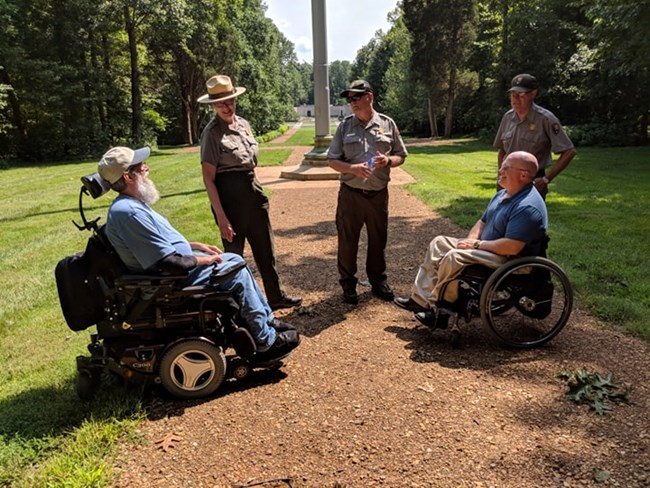Last updated: September 5, 2019
Article
Allee Trail Redesign

NPS/Alexander
In an effort to incorporate the tenets of Universal Design as recommended by the National Center on Accessibility and to insure continued sustainability, Lincoln Boyhood National Memorial is proposing some changes to the park’s cultural landscape that will replace the trail surface of the two parallel trails from the visitor center parking area to the gravesite of Nancy Hanks Lincoln. The proposed changes will blend seamlessly into the current version of the trail and enhance the experience for all visitors while complementing the scenic natural views and meeting the requirements of the Americans with Disabilities Act (ADA) and Architectural Barriers Act (ABA). It will also more closely resemble the original 1927 landscape design of Frederick Law Olmsted Jr. who envisioned a graceful circular path that connected the east and west trails.
Construction
The current proposal includes the replacement of the existing gravel surface with a more permanent material (i.e. paving stones, exposed aggregate) that will be less vulnerable to damage from heavy rainfall and other environmental factors. This will reduce annual maintenance costs associated with repairing the trails. The new surface will also make the trails more accessible for those with mobility issues and will be designed to be compatible with the appearance of the current landscape. The color of the new surface will match the colors found in the current creek gravel surface. Retaining walls, hand rails, and accessible interpretive displays that help share the park story can also be incorporated. The drainage issues associated with the current walkways will be mitigated. It is anticipated that the trail system should have at least a 50-75 year usable lifespan with minimal preventative maintenance.
Phase 1 consists of preparing the construction documents to ensure the design meets the goals of universal accessibility and durability. Phase 2 will consist of changing the route of the pathways and installing a hardened tread surface. Phase 3 will continue with multisensory interpretation and education upgrades that effectively share the story of the significance of the Lincoln family farm where Abraham Lincoln spent his boyhood.
The Estimated Timeline
The 2001 Lincoln Boyhood National Memorial (LIBO) cultural landscape report recognized the need to begin the process of hardening the trail surface to meet the needs of the public and reduce annual maintenance expenditures. The 2011 LIBO accessibility assessment report, supplied by the National Center on Accessibility, highlighted the need to begin planning to make the trail system more accessible to all visitors. In 2015 the park submitted a project proposal for special funding.
In 2017, funding was authorized by the National Park Service. In early 2019, the Allee project was assigned to a regional project manager. The project manager and park staff collaborated to revisit the original 1927 concept and saw the potential for combining historic plans with contemporary needs and materials. The re-worked plan was approved by the park project planning team. The architectural and engineering costs were funded in fiscal year 2019 for the design component. The new design planning and construction documents may be completed by late 2019 or early 2020 with construction scheduled to begin in late 2020 or early 2021.
ADA/ABA
Federal regulations and the National Park Mission, “All In” strives to incorporate accessibility features into the design of new construction as well as in modifications and upgrades to existing park facilities so that federal properties are welcoming to people of all abilities, disabilities and preferences. This project will be completed in a phased approach, with different components being financed over a series of years to fulfill the physical and intellectual accessibility features that welcome visitors with physical and intellectual disabilities, vision and hearing loss. Phase 1 consists of preparing the construction documents to ensure the design meets the goals of universal accessibility and durability. Phase 2 will consist of changing the route of the pathways and installing a hardened tread surface. Phase 3 will continue with interpretation and education upgrades that effectively share the story about the significance of the Lincoln family farm where Abraham Lincoln spent his boyhood.
Public Input
The park staff is currently requesting comments and input from the public and the accessibility community on the different features of the project in order to get feedback about items including trail surface material, the trail route, and accessibility options
An exhibit of the project design and alternatives will be on display at the Memorial Visitor Center beginning July 22. Please visit the exhibit, complete the feedback form with your comments and submit your ideas at the visitor center desk. The public will be invited to public comment meetings during which tours will be given and project plans presented. For more information, contact Park Superintendent Rhonda Schier at
e-mail us
What is Universal Design?
Universal Design is the design and composition of an environment so that it can be accessed, understood and used to the greatest extent possible by all people regardless of their age, size, ability or disability. An environment (or any building, product, or service in that environment) should be designed to meet the needs of all people who wish to use it. This is not a special requirement, for the benefit of only a minority of the population. It is a fundamental condition of good design. If an environment is accessible, usable, convenient and a pleasure to use, everyone benefits. By considering the diverse needs and abilities of all throughout the design process, universal design creates products, services and environments that meet peoples' needs. Simply put, universal design is good design.
